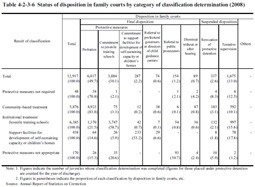| Previous Next Index Image Index Year Selection | |
|
|
2 Classification activities (1) Institutional classificationFig. 4-2-3-5 shows the standard flow of classifications carried out on juveniles for whom a decision of protective detention (commitment to a juvenile classification home) was made (hereinafter referred to as “institutional classification”). Fig. 4-2-3-5 Flow of institutional classification in juvenile classification homes Classification determination is made as to whether to place a juvenile under community-based treatment (probation, etc.) or institutional treatment (commitment to a juvenile training school, etc.), etc. based on the results of classification interviews, psychological tests, behavior observation, and medical diagnosis, as well as external information. The result of the classification is then recorded in a report along with the characteristics of the juvenile’s predisposition, factors that may have lead him/her to delinquency, and treatment guidelines for their reformation/rehabilitation, which is then sent to a family court as data for use in the hearing. If a disposition of protective measures is decided, the result of the classification is sent to the juvenile training school or probation office for use as reference material in the juvenile’s treatment.Table 4-2-3-6 shows the relationship between the classification determination and disposition in family courts, etc. for juveniles whose classification determination was completed (only those placed under protective measures are counted in the year of discharge) in 2008. Table 4-2-3-6 Status of disposition in family courts by category of classification determination (2008) (2) Classification other than institutional classificationa. Non-institutional classification at the request of a family court Although institutional classifications are conducted for most cases dealt with by family courts, non-institutional classifications can also be conducted by summoning juveniles to a family court or juvenile classification home, etc. without detaining them at a juvenile classification home. In 2008, 252 juveniles were received for non-institutional classifications (Source: Annual Report of Statistics on Correction). b. Classification at the request of relevant Ministry of Justice agency The number of persons received for classification at the request of a relevant Ministry of Justice agency in 2008 was five from public prosecutors, 3,516 from juvenile training schools or penal institutions, and 4,288 from Regional Parole Boards or probation offices (Source: Annual Report of Statistics on Correction). The classification activities conducted in response to a request included classification of the subjects’ predisposition, individual or group psychological tests, and interviews and enquiries, etc. conducive to formulating or changing treatment plans, etc. c. Classification services for the general public Classification services for the general public can be conducted at the request of general public and public/private organizations, etc. The content of those consultations is wide-ranging, and can include not only delinquency but also juveniles’ character, discipline, and student guidance, etc. |

